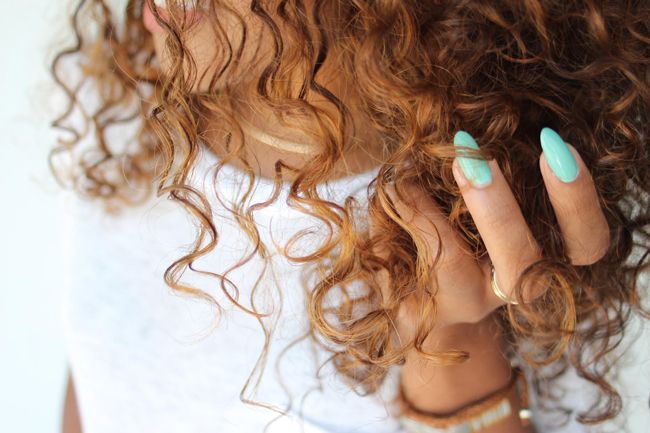
As a NaturallyCurly Editor and community member, I’m pretty proficient in reading my hair product labels at this point. I speak the language of water-soluble silicones and fatty alcohols. I also use sunscreen rated highly by the Environmental Working Group and natural charcoal deodorant, yet somehow I still remain blissfully unaware of what’s in many of the cosmetics I use every day. I realize it’s a contradiction, and speaking with fellow curlies it’s one I believe many of us share.
I firmly believe that embracing your natural hair is just one step in the larger journey to self-love, and for many that journey includes becoming a more conscious consumer and being more thoughtful about what we put on our bodies. One switch I’m in the process of making is from using nail polish brands that contain harmful ingredients to brands that make an effort to leave out these culprits. Here’s what to look for.
What’s so wrong with nail polish?
Leading nail polish brands contain many chemical ingredients that help the formula stay on our nails longer, apply evenly, and prevent them from chipping. Of course we want our nail polish to do all of these things, but at what cost?
Many nail polishes have traditionally contained formaldehyde, toluene, and dibutyl phthalate, three chemicals that have come to be known by public health advocates as the “toxic trio.” Formaldehyde is a known carcinogen while the other two, toluene and dibutyl phthalate, are linked to developmental defects. As brands have been making the move to remove phthalates from their formulas, they have been replacing them with a chemical called triphenyl phosphate, also known as TPP or TPHP. Triphenyl phosphate is a flame retardant used in many household products such as foam cushions in furniture and is used to make plastics, it also helps make nail polish last longer. According to the Environmental Working Group, “TPHP might disrupt hormones in humans, and in animal studies has upset reproductive and development processes.”
Even when brands have stopped listing these toxic ingredients on their product labels, a 2012 investigation by the California Department of Toxic Substances Control found that brands were continuing to use the ingredients in their formulas even after removing them from the labels.
Why does it matter?
Our body absorbs chemicals through our skin, nails, and the air we breathe. You know the strong smell that manages to fill a room when you open a bottle of nail polish? Experts suggest that those airborne toxic chemicals and volatile organic compounds (VOCs”> can be a cause for concern. And while you may only be exposed to trace amounts of these chemicals on your hands and in the air for a relatively brief time period, that’s not true for the thousands of people who work daily in salons. Janet Nudelman, co-founder of the Campaign for Safe Cosmetics, told the New York Times that “No one is saying that occasional application of nail polish will cause long-term health consequences,” but there are certain groups who are exposed to greater risk:- Salon employees – who are exposed to these chemicals all day, every day
- Teens and children – who are especially vulnerable to hormone disruptors during the developmental stages before and during puberty
What to avoid
Even “natural” nail polishes are still going to contain synthetic materials and VOCs that you will be exposed to during the application, wearing and removal, but if you are looking to find nail polishes that don’t contain known harmful ingredients then it’s a good idea to start with the “toxic trio” of formaldehyde, toluene, and dibutyl phthalate. Products that don’t contain the “toxic trio” are common referred to as “three free.” Here’s a short list to look for:
- triphenyl phosphate, aka TPP or TPHP
- formaldehyde
- toluene
- dibutyl phthalate
- formaldehyde resin
- camphor
A few of the popular brands that EWG’s Skin Deep database lists as containing TPHP in their polishes include:
- Sally Hansen
- Essie
- OPI
- butter LONDON
- Revlon
- Wet N Wild
Should you stop using nail polish?
As with all ingredients, it is a personal choice. It is important to note that the studies on the effects of TPHP that have been done so far have been conducted on animals, not humans. As Richard Sachleben, an expert spokesman for the American Chemical Society, points out in the Huffington Post, the results found in the Duke and EWG study hasn’t been directly linked to human health. Keep in mind the high risk groups who may be affected most greatly by use of these products, nail techs, teens and children.
Are there non-toxic alternatives? There are brands who are working to produce safe formulas, and they do come in a wide range of colors. Scotch Naturals, Acquarella, and Piggy Paint are a few who I have seen widely reviewed. From the reviews I’ve read, these non-toxic alternatives may not have the same staying power that you’re used to with traditional polishes, but can still have a bright, shiny finish. Blogger Wellness Mama tested out many of the leading non-toxic nail polishes on herself and her daughters, and you can read their review here.I’d love to know, do you avoid chemicals in all of your cosmetics and household products? Or mostly just in your hair?
And if you’ve found a “three free” nail polish that you love, please share it below!
What’s next?
Want to know what to look out for in hair products? Here are 5 ingredients to know and avoid.
It’s not all bad, here are 4 ingredients that are good for your hair and your face.
Like what you see? For more articles like this, sign up for our newsletter!
